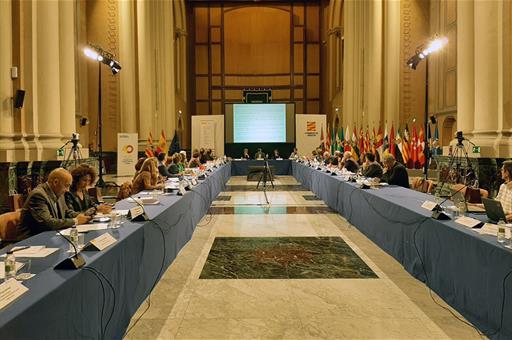The jota to be declared a Representative Manifestation of Intangible Cultural Heritage
News - 2022.10.25
The Historical Heritage Council was chaired by its Director General of Cultural Heritage and Fine Arts, Isaac Sastre de Diego, and met in the Pignatelli building, headquarters of the Diputación General de Aragón, in Zaragoza.
To this effect, this collaborative body, in which all the autonomous communities take part, ratifies its commitment to the jota as Spain's next candidate for UNESCO Intangible Cultural Heritage. Its declaration as a Representative Manifestation under Law 10/2015 on the Safeguarding of Intangible Cultural Heritage is a necessary requirement in the processing of the candidacy dossier in which 15 autonomous communities are taking part, coordinated by the Ministry.
The jota is currently the most widespread, diverse, dynamic and reinterpreted traditional genre of all the traditional genres that make up the varied sound and musical map of Spain. Its popularity is shared and widely considered by regions and counties, generating a rich and diverse spectrum of tradition and live performance.
The process for its declaration as a Representative Manifestation of the Intangible Cultural Heritage of Spain and as a candidacy for the Representative List of the Intangible Cultural Heritage of Humanity, supported by 15 autonomous communities, demonstrates the deep roots that the jota has in today's society and in the collective memory and imaginary.
Sustainable heritage management
Another central theme at this Heritage Council meeting was the presentation of initiatives relating to sustainability and cultural heritage management. The Ministry of Culture and Sport shared the progress made in the drafting of the 'Green Paper for the sustainable management of cultural heritage', an initiative defended by the Minister for Culture and Sport, Miquel Iceta, at the Euro-Mediterranean conference of Ministers for Culture held in Naples last summer. The project is being developed through working groups involving different associations and institutions relating to cultural heritage management. It will bring together tools and recommendations for cultural managers to develop their work based on social, cultural and environmental sustainability criteria.
Furthermore, the working group coordinated by the Ministry and in which different autonomous communities take part, whose task is to analyse the impact of renewable energies on cultural heritage and how to manage it in relation to cultural landscapes and historic centres, was presented.
Likewise, as part of the work that the Ministry is carrying out for the revision and reactivation of the National Plans, the Historical Heritage Council has approved the creation of a new National Archaeology Plan aimed at generating lines of action to protect this type of heritage.
International mission
The Council was also informed of the details of Spain's participation in the UNESCO mission on the Skerki Banks, the first international underwater archaeology campaign in which our country is taking part, the results of which will be presented in January.
The project, in which eight countries took part, was attended by two archaeologists from the Ministry of Culture and Sport, and was a positive experience of international collaboration for the protection of underwater cultural heritage.
Among the international proposals, there is also the candidacy for Intangible Cultural Heritage of the Fiesta de los Pecados y los Danzantes del Corpus Christi de Camuñas (Castilla-La Mancha). This inscription on the UNESCO Representative List would mean an extension, on the part of Spain, of the festivals recorded by Venezuela in 2012. With this binational bid, the two territories would be united by a common element: the representation of the struggle between good and evil on the day of Corpus Christi.
Non official translation





